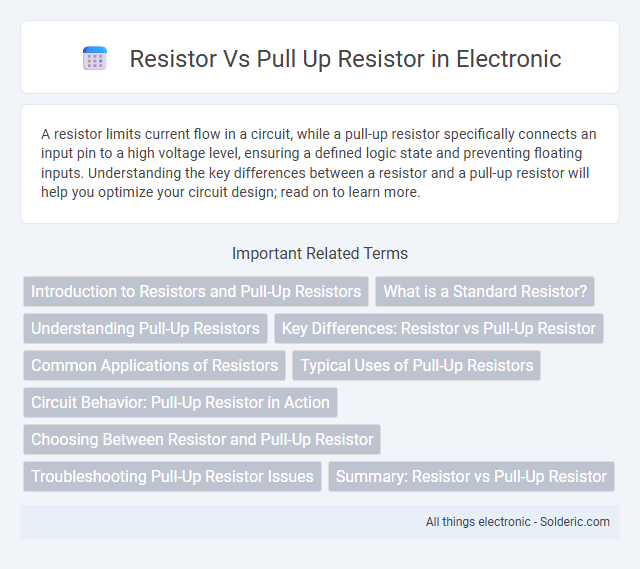A resistor limits current flow in a circuit, while a pull-up resistor specifically connects an input pin to a high voltage level, ensuring a defined logic state and preventing floating inputs. Understanding the key differences between a resistor and a pull-up resistor will help you optimize your circuit design; read on to learn more.
Comparison Table
| Feature | Resistor | Pull-Up Resistor |
|---|---|---|
| Definition | Passive electrical component that limits current flow | Resistor connected between a signal line and a positive voltage supply |
| Purpose | Control current, divide voltage, or set bias | Ensure a default high logic level on digital inputs |
| Placement | Anywhere in the circuit for current control | Between input pin and Vcc (positive voltage rail) |
| Typical Value | Varies widely (ohms to megaohms) based on function | Usually 1kO to 10kO |
| Common Use Cases | Voltage divider, current limiting, biasing | Prevent floating input states, stabilize microcontroller inputs |
| Effect on Signal | Depends on application; can reduce voltage or current | Keeps signal line at a logic HIGH level when not driven |
Introduction to Resistors and Pull-Up Resistors
Resistors control electrical current by providing resistance measured in ohms, essential for protecting components and managing voltage levels in circuits. Pull-up resistors specifically connect a signal line to a positive voltage supply to ensure a defined logical high state when no other active device drives the line. Both types are fundamental in digital electronics, with pull-up resistors preventing floating inputs and stabilizing signal integrity.
What is a Standard Resistor?
A standard resistor is a passive electrical component designed to provide a specific resistance value in an electronic circuit, limiting current flow and dividing voltage as needed. Unlike a pull-up resistor, which is connected between a signal line and a positive voltage supply to ensure a defined logic level, a standard resistor can be used in various configurations for general resistance purposes. Standard resistors have fixed resistance values, typically measured in ohms, and are available in precise tolerances and power ratings to suit diverse electronic applications.
Understanding Pull-Up Resistors
Pull-up resistors are specialized resistors connected between a voltage source and a digital input to ensure the input reads a defined high logic level when no active device is driving the line. Unlike general resistors used for current limitation or voltage division, pull-up resistors maintain a stable reference voltage, preventing floating inputs that can cause erratic circuit behavior. Typical pull-up resistor values range from 1 kO to 10 kO, balancing power consumption and signal reliability in microcontroller and digital logic applications.
Key Differences: Resistor vs Pull-Up Resistor
A resistor limits current flow and divides voltage in circuits, while a pull-up resistor specifically ensures a defined voltage level by connecting an input pin to a positive voltage supply, preventing floating states. Pull-up resistors are crucial for digital logic inputs, maintaining a stable high level when no active signal is present. Understanding your circuit's needs helps determine whether a general resistor or a pull-up resistor is appropriate for reliable performance.
Common Applications of Resistors
Resistors are widely used in electronic circuits to control current flow, divide voltages, and protect components from excessive current. Pull-up resistors specifically ensure a defined logic level on input pins by connecting them to a positive voltage supply, preventing floating states that can cause erratic behavior. Your circuit design benefits from the precise application of standard resistors for current regulation and pull-up resistors for stable digital signal detection.
Typical Uses of Pull-Up Resistors
Pull-up resistors are commonly used in digital circuits to ensure a defined logic level on input pins, preventing floating states that can cause unpredictable behavior. They connect the input signal to a high voltage level, typically 3.3V or 5V, through a resistor, stabilizing signals from switches, sensors, or microcontroller inputs. Typical applications include interfacing with open-drain or open-collector outputs, confirming default HIGH states on microcontroller GPIO pins, and enabling proper operation of I2C bus lines.
Circuit Behavior: Pull-Up Resistor in Action
A pull-up resistor ensures a defined voltage level by connecting the input pin to a positive supply voltage, preventing floating inputs and unintended signals in digital circuits. Unlike a regular resistor that limits current, the pull-up resistor maintains a stable logic HIGH state when the switch or sensor is open. This behavior is critical in microcontroller inputs, avoiding erratic behavior and ensuring reliable circuit operation.
Choosing Between Resistor and Pull-Up Resistor
Choosing between a resistor and a pull-up resistor depends on the specific circuit function and desired signal behavior. A standard resistor primarily limits current or divides voltage, while a pull-up resistor ensures a defined high voltage level on a floating input, preventing undefined states. Your choice impacts signal stability and noise immunity in digital electronics, especially in microcontroller input configurations.
Troubleshooting Pull-Up Resistor Issues
Troubleshooting pull-up resistor issues involves verifying the resistor value to ensure it matches the required specifications, typically between 4.7kO and 10kO for most digital circuits, to maintain proper signal levels and prevent floating inputs. Check for poor solder joints or broken traces that can cause intermittent connections, resulting in unreliable voltage readings. Measuring voltage at the node can identify if the pull-up resistor is effectively holding the line high, as a voltage significantly below the supply voltage indicates a possible resistor failure or incorrect placement.
Summary: Resistor vs Pull-Up Resistor
A resistor limits current flow and controls voltage within electronic circuits, while a pull-up resistor specifically connects the input pin to a high voltage level, ensuring a defined logic state when no active device is driving the line. Pull-up resistors prevent floating inputs by providing a default "HIGH" signal, crucial for stable digital logic operations. Understanding the distinction helps you design reliable circuits by selecting the correct resistor type for your intended signal control.
resistor vs pull up resistor Infographic

 solderic.com
solderic.com